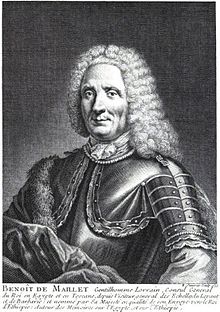Benoît de Maillet
Benoît de Maillet (born April 12, 1656 in Saint-Mihiel , † January 30, 1738 in Marseille ) was a French diplomat, traveler, historian and geologist.
He came from a respected noble family in Lorraine and received private tuition. He was interested in natural history and traveled a lot. From 1692 to 1708 he was French consul general in Cairo , where he was mainly involved in difficult negotiations about customs duties, and from 1712 to 1717 in Livorno . From 1715 until his retirement in 1720 he was a French diplomat responsible for the Levant and barbarism . In retirement he lived in Marseille.
De Maillet published in Amsterdam in 1748 a highly speculative vision of a cyclical emergence and decay of life on earth and the geological development of the earth from a solar-like hot state to a cooling one. When the oceans dried up, land life emerged from the ubiquitous life seeds ( panspermia ) and precursor forms in the water (there were also mermen and women as precursors in humans). According to him, the decay of accumulating organic masses creates new heat, volcanism and a new solar-like phase of the cycle. According to Maillet, rocks are formed by sedimentation in the sea, and the new layers slide off the flanks of the primeval mountains when the sea recedes. Maillet can thus be regarded as an early Neptunist . He calculates the age of the earth, or the duration of the cycles, from the height of today's mountains and assumptions of a continuous slow fall of the sea level, recognizable by today's dry harbors, over several million years. That was a very high estimate for that time and up to the 19th century.
The work was written between 1722 and 1732 and was published long after his death by the editor, the Abbé Jean-Baptiste Le Mascrier . The editor was a Catholic clergyman and tried to reconcile de Maillet's views with Catholic teaching. A critical edition based on surviving manuscripts appeared in 1920. The book takes the form of a dialogue between an Indian philosopher and a French missionary.
In Egypt, he was also interested in archeology, visited the pyramids and sent mummies to France. He learned Arabic and wrote a description of Egypt which Mascrier published in 1735. Maillet was disappointed with the editing. Another manuscript (Mémoires sur l'Éthiopie) never appeared.
Fonts
- Description de l'Égypte , 1735
- Telliamed ou entretiens d'un philosophe indien avec un missionnaire françois, sur la diminution de la Mer, la formation de la Terre, l'origine de l'Homme, etc. Amsterdam, 2 volumes 1748, 3rd edition, The Hague, Paris 1755 (with biography)
- New editions of Telliamed
- Albert V. Carozzi: Teliamed, or conversations between an Indian philosopher and a French missionary on the diminution of the sea. University of Illinois Press, Urbana, Chicago & London 1968
- Fritz Neubert: Introduction to a critical edition of B. de Maillet's Telliamed ou Entretiens d 'un philosophe indien avec un missionnaire françois. A contribution to the history of French enlightenment literature. Emil Ebering, Berlin 1920
- A new French edition was published by Fayard, Paris 1984
literature
- Helmut Hölder : Brief history of geology and paleontology. Springer 1989
- Albert V. Carozzi: De Mailett's Telliamed (1748): An ultra-neptunian theory of the Earth. In: CJ Schneer (Ed.): Toward a history of geology. 1969
- Claudine Cohen: La Genèse de Telliamed. Benoît de Maillet et l'histoire naturelle à l'aube des Lumières, Paris, 1989
- Claudine Cohen: Le Transformisme de Telliamed. Science, clandestinité et libertinage à l'aube des Lumières, Paris, PUF, 2011
- Miguel Benítez: Benoît de Maillet et la littérature clandestine. Étude de sa correspondance avec l'abbé Le Mascrier , Studies on Voltaire and the eighteenth century, No. 183, 1980, pp. 133-159
- Jacques Roger: La théorie de la Terre au XVIIe siècle , Revue d'histoire des sciences, Volume 26, 1973, pp. 23-48
References and comments
- ↑ The water disappeared in eddies, an idea that went back to Descartes
| personal data | |
|---|---|
| SURNAME | Maillet, Benoît de |
| BRIEF DESCRIPTION | French diplomat and geologist |
| DATE OF BIRTH | April 12, 1656 |
| PLACE OF BIRTH | Saint-Mihiel |
| DATE OF DEATH | January 30, 1738 |
| Place of death | Marseille |
